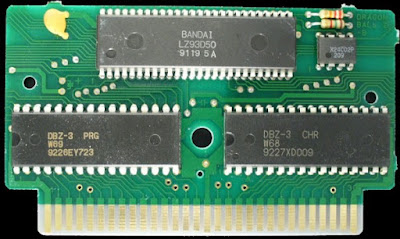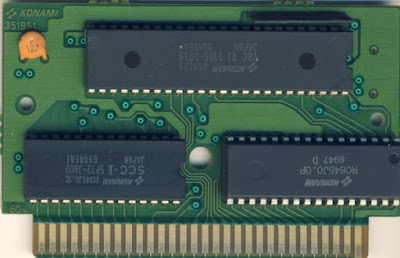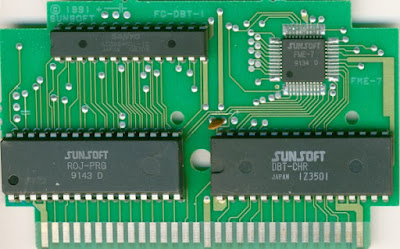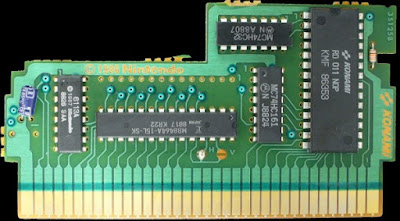I have often read that Nintendo, as of the Nintendo Entertainment System and everything thereafter, made all cartridges for its systems and required third parties to buy chips, board and other raw materials from them in order to have their software run on Nintendo's systems. While this was often true, the rule was not an absolute one and at times exceptions were made.
Nintendo does not make anything, it does not construct silicon wafers, it does not extrude plastic into molds, it does not own factories or fabrication plants which do these things. Nintendo designs and patents chips and products, but turning those designs into reality is a function of contractors. Obviously Nintendo has to work closely with those contractors to ensure its designs can translate into workable devices, but it is not correct to say that Nintendo really "made cartridges". In this article we will look at instances where Nintendo permitted third party cartridges to be made.
Famicom
 |
| Hoshi no Kirby - Nintendo Made Cartridge |
When Nintendo was first looking for third-party developers to publish games for its first video game console, the Family Computer, it approached many of the biggest companies in arcade and toy gaming in Japan. The terms Nintendo offered were generous by later standards. If these 3rd parties would publish games for the Famicom, Nintendo would give them technical documentation and allow them to manufacture their own cartridges so long as they adhered to a loose set of guidelines (no adult games mainly). Konami, Bandai, Jaleco, Namco, Irem, Sunsoft and Taito were the first third party developers who signed up and thus made their own cartridges. Their cartridges varied in shape and size somewhat from Nintendo-manufactured cartridges.
 |
| Dragon Ball Z III - Bandai Made Cartridge |
Hudson was also in this first class of third party developers but did not manufacture its own Famicom cartridges. It seems Hudson had a different deal with Nintendo, trading away its right to manufacture cartridges in exchange for the right to port Nintendo's games to Japanese home computers.
 |
| Akumajou Densetsu - Konami Made Cartridge |
Later third party developers like Capcom, Seta, Enix, Square and Kemco always used Nintendo-made cartridges. They were not offered the same generous terms that Nintendo offered to the first third party licensees. Nintendo was in a stronger bargaining position due to the success of the Famicom and no longer needed to be generous. These third parties had to choose from the cartridge and chips that Nintendo offered. If they needed to use a mapper they were generally limited to Nintendo's UNROM, CNROM, GNROM, MMC1 and MMC3 mappers. Unlike later systems and overseas Nintendo systems, Famicom cartridges came in a variety of colors, so Japanese third parties had more choice in their Famicom cartridge design than their NES cartridge design.
 |
| Dynamite Batman - Sunsoft Made Cartridge |
Namco always used its own PCBs, ROMs and mapper chips. The other first-class licensees would occasionally use a Nintendo made cartridge, which limited them to the mapper chips Nintendo developed, the MMC family, and the generic logic mapper boards Nintendo made available. While Bandai always used its own hardware on games it published itself, when it published under its Shinsei label, it used Nintendo's hardware.
As these third parties were permitted to use whatever they wanted inside their cartridges, this sparked a great deal of innovation. A critical period of innovation was the period from 1986 to 1988 where third party developers were using custom-made ASICs to replace the simpler generic logic mappers found on earlier games. From late 1985 to early 1987, Nintendo's official stance was that the Famicom Disk System was the way forward for hardware innovation on the Famicom, but the limitations of the Disk System and the falling memory prices made cartridges more attractive to most third party publishers.
 |
| Image Fight - Irem Made Cartridge |
The third parties showed that they could still make money with cartridges with larger memory sizes thanks to mappers, and they spent considerable resources devices ever more capable mapper chips. With mapper chips battery backed save games became possible, previously a save game had to be stored as a password, on a Famicom Disk System game, or very occasionally through a tape deck. The amount of memory the Famicom could address was limited to 32KiB of PRG-ROM and 8KiB of CHR-ROM without mapper chips, but by the end of the Famicom's life there were cartridges supporting well over 10x that amount of memory. Mapper hardware could make displaying status bars less CPU intensive through scanline-timed interrupts, changing the video memory mirroring to allow for more convenient horizontal and vertical scrolling and allow for background tile animations thanks to fast switching of CHR-ROM memory banks.
 |
| Rolling Thunder - Namco Made Cartridge |
The Famicom enjoyed a remarkably long life, games were released for it from 1983 to 1994. This was far longer than any console released previously in Japan and many of which would come after. By 1987, the capability of affordable silicon found its way into Famicom cartridges in the form of expansion audio, something once previously exclusive to the Disk System. Konami, Bandai, Jaleco, Namco and Sunsoft all released cartridges which supported expansion audio. Nintendo also had an advanced mapper chip called the MMC5 which supported some expansion audio, among other things, but its features were barely tapped due to the lateness of the chip (1990) in relation to the Famicom's lifespan.
Once the Super Famicom was released in November of 1990 the Famicom became the budget console and innovation more or less stopped at this point. The Nintendo MMC6 was not an advancement on the MMC5 but sort of an alternate MMC3. No more chips were designed with expansion audio in mind and the one chip that post-dates 1990 and used expansion audio, the Sunsoft 5B, was merely a Sunsoft FME-7 with added audio. Namco simplified its N163 mainstay (with expansion audio) into simpler N175 and N340 chips (expansion audio-less).
NES
 |
| Contra - Nintendo Made PCB |
 |
| Life Force - Konami Made PCB |
Konami, both under its own label and under its Ultra Games label, manufactured PCBs and ROM chips for several of their games. Life Force, Super C, Teenage Mutant Ninja Turtles are all examples of games which used Konami boards and ROMs. These games used UNROM, MMC3 and MMC1, respectively. UNROM only uses generic 74-series TTL logic chips to implement its simple bankswitching scheme, but the MMC1 and MMC3 chips were custom chips made by Nintendo.
Many, but not all of these Konami boards seem to coincide with the great chip shortage of 1988. I imagine a scenario where Konami pleaded with Nintendo to allow them to handle some of the board and chip manufacture to lower costs, and Nintendo agreed. One of Nintendo's conditions may have been that Konami had to use Nintendo's custom chips (instead of Konami's own) if their games could not be made to work with simple TTL logic based mappers like UNROM, CNROM or GNROM.
Certain games, such as Gauntlet, Karnov, R.B.I. Baseball, Ring King, use a Namcot 109 chip. The Namcot 109 functioned similarly to the Nintendo MMC3 chip but with significantly fewer features. The Nintendo-licensed version of Gauntlet can come either with a Namco 109 or Nintendo MMC3 chip. When Tengen went unlicensed, it still used these Namcot 109 chips, but in a different packaging.
 |
| Karnov - Namco 109 Chip, Nintendo PCB |
Sunsoft went further than either Konami or Tengen. It's Batman: Return of the Joker used both a Sunsoft board and a Sunsoft custom mapper chip, the FME-7, but only for the US version. European versions used a Nintendo PCB designed for the FME-7, which was also used for the European exclusive release of Mr. Gimmick!
Acclaim was rather unusual in that it did both PCBs, ROMs and a hardware clone of Nintendo's MMC3 chip. Thirteen of its games, including such "classics" as T2: Terminator 2: Judgment Day and George Foreman's KO Boxing use a chip called the MC-ACC which is Acclaim's clone of the Nintendo MMC3 chip. This chip has a somewhat different IRQ counter, and there will be visual glitches in The Incredible Crash Dummies and Mickey's Safari in Letterland if it is emulated like an MMC3. Acclaim did use a Nintendo MMC3 chip for Smash TV and Nintendo's AOROM TTL logic mapper for Wizards & Warriors III.
 |
| Batman Return of the Joker - Sunsoft Made PCB |
Virgin Games made its own PCB and supplied its own ROM chip for Overlord but used Nintendo's MMC1 mapper chip.
 |
| Mickey's Safari in Letterland - Acclaim Made PCB |
Except for Sunsoft, almost all non-Nintendo made NES PCBs are inferior to Nintendo's PCBs. Konami's boards use pad-printed vias instead of the more robust plated through-hole vias Nintendo used. Acclaim, Virgin and unlicensed Tengen boards to not apply a solder mask over the PCB traces, making them more vulnerable to damage and corrosion. Nintendo's own PCB has the solder mask extend a little over the border between the cartridge pins and the end of the traces to help protect the area where the signal trace narrows considerably. All licensed games still contained a Nintendo-produced lockout chip, so there was always an official Nintendo presence of some sort inside an NES cartridge.
One final word about cartridge quality. Famicom carts, even ones made by Nintendo, sometimes used epoxy-bonded chips, a.k.a. "glop tops". The epoxy is necessary to protect the bonding wires connecting the delicate silicon chip to the board. Epoxy is typically used for mask ROMs but can also be used for other kinds of chips, logic chips, mapper ASICs or even RAM. Plastic-encased chip packages with metal pins are generally seen as a higher quality of manufacture. Nintendo seldom used epoxy-bonded ROMs in Famicom cartridges once mapper chips were being used, but some third parties continued to use them regularly (Namco was notorious for this). Nintendo-made NES cartridges only used epoxy-bonded chips for games with Famicom boards with a pin converter, for most of its Super Mario Bros. / Duck Hunt cartridges and for all Super Mario Bros. / Duck Hunt / World Class Track Meet, Super Spike V'Ball/Nintendo World Cup and Super Mario Bros./Tetris/Nintendo World Cup cartridges.
 |
| Overlord - Virgin Games PCB, ROMs, Nintendo MMC1 |
Super Famicom and Super Nintendo
Nintendo released all Super Famicom and Super Nintendo PCBs with the exception of the Bandai SuFami Turbo, an expansion device which could accept two mini-cartridges at a time. 3rd-party enhancement chips found their way into certain SNES and Super Famicom games. Nintendo offered or used the DSP 1-4, the OBC-1, the Super FX, the SA-1, the SDD-1 and the chip which provides the functionality for the Nintendo Power rewritable cartridge. Capcom had the CX4 for Mega Man X2 and X3. Hudson used the SPC7110 in Tengai Makyou Zero (Far East of Eden Zero), Momotaro Dentetsu Happy, and Super Power League 4. SETA's ST010 was found in Exhaust Heat II / F1 Roc 2, the ST011 in Hayazashi Nidan Morita Shogi and the ST018 in Hayazashi Nidan Morita Shogi 2.
The only time a Super Nintendo or Super Famicom cartridge used epoxy-bonded chips was for the production of some Star Fox cartridges, including the Official Star Fox Competition cartridges.
Game Boy and Game Boy Color
As far as I can tell, all licensed Game Boy and Game Boy Color games used Nintendo-branded PCBs, with the exception Game de Hakken!! Tamagotchi - Osutchi to Mesutchi. That game was released by Bandai on a Bandai board and using chips not marked by Nintendo. Hudson used boards with its HuC-1 and HuC-3 chips, but the boards have the Nintendo logo on them. It is hard to say whether Nintendo manufactured the cartridge PCB for Pocket Sonar, but the board bears the design hallmarks of Nintendo.
Only some Tetris cartridges used an epoxy-bonded ROM chip on licensed Game Boy or Game Boy Color games, but most late DMG Game Boy consoles (especially Play-it-Now! color) used epoxy bonded chips for all chips on the main PCB.
Nintendo 64
Nintendo manufactured all N64 licensed cartridges with one exception, Morita Shogi 64. This game was released by SETA and unique for a video game cartridge, has a built-in modem. You can plug in an RJ-11 telephone cable, but the service to which it connects shut down at least a decade ago. The PCB for the game was made by SETA and includes the SETA ST031 and ST034 chips. Nintendo supplied the lockout chip and probably the ROM chip containing the game's code.
Sega
In the early days, when Sega had released the SG-1000, it allowed a clone of it to be made by Tsukuda Original called the Othello Multivision, it was something of a cross between the basic SG-1000 and the full keyboard version, the SC-3000. Tsukuda Original manufactured nine cartridge games under the Othello Multivision branding which were compatible with the SG-1000.
While Sega seemingly manufactured all the cartridges for its principal 8-bit systems, the Mark III, the Master System and the Game Gear, there was one exception to the rule. Codemasters used a different mapper chip for its Master System and Game Gear games than any other licensee did. Its three released Master System cartridges were shaped differently from Sega's, they used a somewhat more rounded top and had a sticker with a picture on it rather than the red grid and plain text design Sega used. Codemasters ten released Game Gear cartridges were less physically distinctive to Sega's, but they still had some differences. One imagines that Sega made this concession to help it succeed in the European market.
The Sega Genesis was a little different. In addition to Codemasters, Electronic Arts, Accolade/Ballistic and Sunsoft made their own cartridges. Codemasters' main cartridge innovation was the J-cart, which added two controller ports for four player action on the cartridge itself. J-carts were unique to Codemasters. EA and Accolade were originally publishing Genesis games without a license, but when they later agreed to get a license from Sega, they still used their own cartridges rather than buying from Sega. Sunsoft only produced its own cartridges for Japan but stopped the practice toward the end of the Mega Drive era. Stormlord from RazorSoft was published in the US in a unique cartridge due to a dispute between it and Sega about the number of cartridges to be made.
Picture Credit
All Famicom and NES PCB shots were taken courtesy of BootGod's NES Cartridge Database.

Very interesting! Do you have any idea how much cartridges cost to manufacture in the 1980s? I'm curious about Nintendo's minimum required order, which I think was 10,000 cartridges, and what that would require of a game developer at the time.
ReplyDeleteI remember a US or European developer saying that they had to advance $250K to get a run of cartridges made, so $25 per cartridge seems a ballpark figure.
Delete